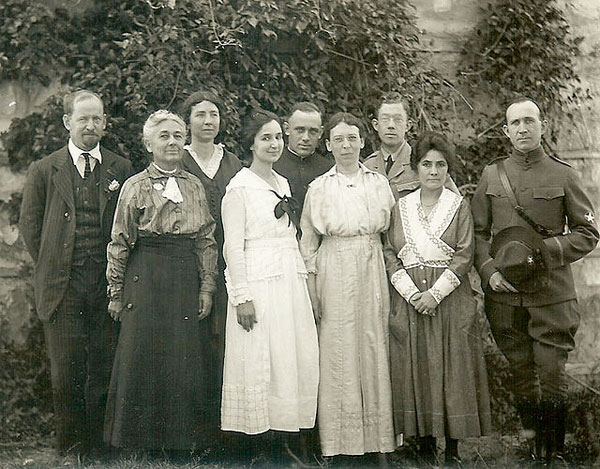
A group of American mission workers serving in relief efforts in Armenia during the genocide. These American Board of Missions and Near East Relief personnel remained in Marash after the battle of Jan. 1920: (from left) Rev. James K. Lyman, Ellen Blakely, Kate Ainslie, Evelyn Trostle, Paul Snyder, Bessie Hardy, Stanley E. Kerr, Mrs. Marion Wilson, and Dr. Marion Wilson. Photograph by Dr. Stanley E. Kerr.
By Frank Ramirez
“Ten thousand Armenians are reportedly massacred and now the French troops are evacuating the city. I have decided to stay with my orphans and take what comes. This may be my last letter. Whatever happens, rest assured God’s in heaven and all’s well. I am working in the day time and often in the night at the emergency hospital. Believe me, war is hell.”
So wrote Evelyn Trostle (1889-1979), a Brethren relief worker from McPherson, Kan., on Feb. 10, 1920, from Marash, in Asia Minor, where the genocide inflicted by the Turkish government and people upon the Armenian population continued unabated.
As Brethren recognize and remember the untold suffering of the Armenian people, which began in April 1915 and led to the death of one to five million people, it is also important to recognize that the response from Brethren was out of all proportion to the size of our church.
People of good will around the world, including Americans, even in the midst of the First World War, were shocked by the reports that came out of the region. Brethren missionary magazines told the story of the intense and unprecedented slaughter of innocent children, women, and men.
Brethren first of all responded with unprecedented generosity. The $250,000 raised by folks in the pews by 1920 would be worth $3 million to $4 million today.
In addition, in an era where ecumenism was largely unheard of, Brethren worked alongside Christians from many different backgrounds through the American Committee for the Relief in the Near East.
The Annual Meeting report for 1920 commended A.J. Culler for his work in organizing Brethren cooperative efforts in Armenia, noting that the “money was given more with a desire to save starving humanity than it was for any personal benefit or credit which might come individually to the Church of the Brethren.”
When the political situation deteriorated, aid workers including most Brethren were evacuated, but as the report notes: “Sister Evelyn Trostle, who has been stationed at Marash by the Near East Committee, witnessed some of the terrible massacres of which you have read during the winter months. She preferred to remain by her post of duty, trusting God for protection, rather than to desert her orphans to the mercies of the cruel Turk. She is a noble example of the self-sacrificing labors of the relief workers.”
Trostle saved the lives of hundreds of children by her presence during the massacres in early 1920. She was encouraged by the Armenians she served to return to the United States to tell their story, which she did at great peril, riding horseback across hundreds of miles of dangerous territory.
Trostle, formerly an instructor at McPherson College, went on to spend much of her life on the West Coast, raising money for Armenian relief and telling the story of what she had observed. The Brethren relationship with the Armenian people continued with an active partnership through the University of La Verne in southern California.
–Frank Ramirez is a Church of the Brethren pastor, writer, historian, and frequent contributor to Newsline and “Messenger.” His sources for this story include Minutes of Annual Meeting 1920, pp. 38-39; The New York Times, March 10, 1920; and personal interviews by the author. See also “Who Will Protect the Children?” in Ramirez’ book “The Meanest Man in Patrick County and Other Unlikely Brethren Heroes” (Brethren Press, 2004). Order the book at www.brethrenpress.com/ProductDetails.asp?ProductCode=8593